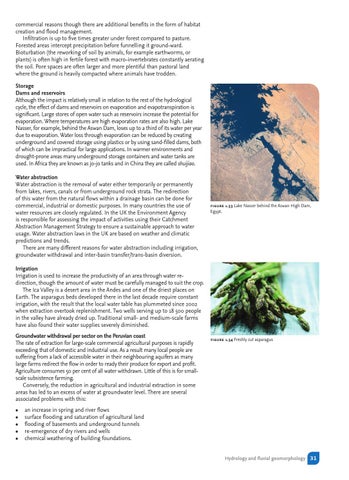commercial reasons though there are additional benefits in the form of habitat creation and flood management. Infiltration is up to five times greater under forest compared to pasture. Forested areas intercept precipitation before funnelling it ground-ward. Bioturbation (the reworking of soil by animals, for example earthworms, or plants) is often high in fertile forest with macro-invertebrates constantly aerating the soil. Pore spaces are often larger and more plentiful than pastoral land where the ground is heavily compacted where animals have trodden. Storage Dams and reservoirs Although the impact is relatively small in relation to the rest of the hydrological cycle, the effect of dams and reservoirs on evaporation and evapotranspiration is significant. Large stores of open water such as reservoirs increase the potential for evaporation. Where temperatures are high evaporation rates are also high. Lake Nasser, for example, behind the Aswan Dam, loses up to a third of its water per year due to evaporation. Water loss through evaporation can be reduced by creating underground and covered storage using plastics or by using sand-filled dams, both of which can be impractical for large applications. In warmer environments and drought-prone areas many underground storage containers and water tanks are used. In Africa they are known as jo-jo tanks and in China they are called shuijiao. Water abstraction Water abstraction is the removal of water either temporarily or permanently from lakes, rivers, canals or from underground rock strata. The redirection of this water from the natural flows within a drainage basin can be done for commercial, industrial or domestic purposes. In many countries the use of water resources are closely regulated. In the UK the Environment Agency is responsible for assessing the impact of activities using their Catchment Abstraction Management Strategy to ensure a sustainable approach to water usage. Water abstraction laws in the UK are based on weather and climatic predictions and trends. There are many different reasons for water abstraction including irrigation, groundwater withdrawal and inter-basin transfer/trans-basin diversion.
figure 1.33 Lake Nasser behind the Aswan High Dam, Egypt.
Irrigation Irrigation is used to increase the productivity of an area through water redirection, though the amount of water must be carefully managed to suit the crop. The Ica Valley is a desert area in the Andes and one of the driest places on Earth. The asparagus beds developed there in the last decade require constant irrigation, with the result that the local water table has plummeted since 2002 when extraction overtook replenishment. Two wells serving up to 18 500 people in the valley have already dried up. Traditional small- and medium-scale farms have also found their water supplies severely diminished. Groundwater withdrawal per sector on the Peruvian coast The rate of extraction for large-scale commercial agricultural purposes is rapidly exceeding that of domestic and industrial use. As a result many local people are suffering from a lack of accessible water in their neighbouring aquifers as many large farms redirect the flow in order to ready their produce for export and profit. Agriculture consumes 50 per cent of all water withdrawn. Little of this is for smallscale subsistence farming. Conversely, the reduction in agricultural and industrial extraction in some areas has led to an excess of water at groundwater level. There are several associated problems with this: • • • • •
figure 1.34 Freshly cut asparagus
an increase in spring and river flows surface flooding and saturation of agricultural land flooding of basements and underground tunnels re-emergence of dry rivers and wells chemical weathering of building foundations.
Hydrology and fluvial geomorphology 31
